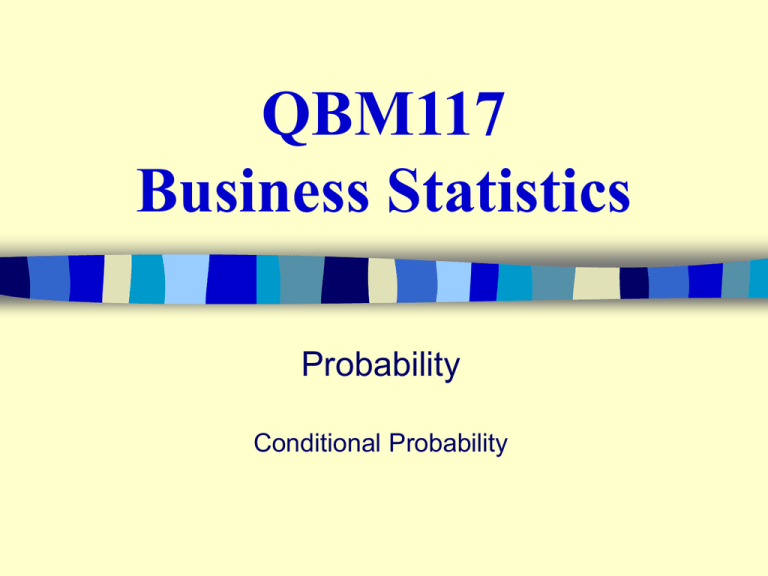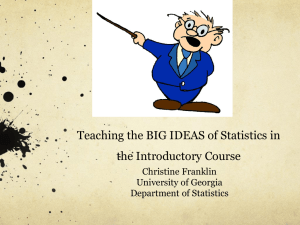
QBM117
Business Statistics
Probability
Conditional Probability
Objectives
• To calculate probabilities from contingency tables
• To develop an understanding of conditional
probability
• To introduce the multiplication rule
• To differentiate between dependent and independent
events
Contingency Tables
• There are several ways in which a sample space can
be viewed.
• One way involves assigning the appropriate events to
a contingency table.
Example 1
The police force consists of 1200 officers, of which
960 are males ad 240 are females. Over the past two
years, 324 officers on the police force have been
awarded promotions, of which 288 are males and 36
are females.
Present this information in a contingency table.
Male
Promoted 288
Promotional Not
672
Status
promoted
Total
960
Sex
Female Total
36
324
204
876
240
1200
Calculating Probabilities from a
Contingency Table
• We can calculate simple and joint probabilities from
contingency tables.
• Simple probability is also called marginal probability,
as the total number of members in an event can be
obtained from the appropriate margin of the
contingency table.
Example 1 revisited
Male
Promoted 288
Promotional Not
672
Status
promoted
Total
960
Sex
Female Total
36
324
204
876
240
1200
What is the probability that a randomly selected
officer is a man?
What is the probability that a randomly selected
officer is a man?
M = event that an officer is a male
F = event that an officer is a female
960
P( M )
1200
0.80
240
P( F )
1200
0.20
Note that F is the complement of M and hence
P(F) = 1-P(M)
Male
Promoted 288
Promotional Not
672
Status
promoted
Total
960
Sex
Female Total
36
324
204
876
240
1200
What is the probability that a randomly selected
officer is promoted?
What is the probability that a randomly selected
officer is not promoted?
A = event that an officer is promoted
A = event that an officer is not promoted
324
P ( A)
1200
0.27
876
P ( A)
1200
0.73
Note that A is the complement of A and hence
P(A) = 1-P(A)
Male
Promoted 288
Promotional Not
672
Status
promoted
Total
960
Sex
Female Total
36
324
204
876
240
1200
What is the probability that a randomly selected
officer is a man and is promoted?
What is the probability that a randomly selected
officer is a man and is not promoted?
The probability that a randomly selected officer is
male and is promoted:
288
P( M and A)
1200
0.24
The probability that a randomly selected officer is
male and is not promoted:
672
P( M and A)
1200
0.56
The probability that a randomly selected officer is
female and is promoted:
36
P( F and A)
1200
0.03
The probability that a randomly selected officer is
female and is not promoted:
204
P( F and A)
1200
0.17
Conditional Probability
• Often the probability of an event is influenced by
whether of not a related event has occurred.
• The probability of such an event is called a
conditional probability.
• We want to know the probability of the event given
the condition that a related event has occurred.
• The probability of event A occurring, given that event
B has already occurred is
P( A and B)
P( A | B)
P( B)
• The probability of event B occurring, given that event
A has already occurred is
P( B and A)
P( B | A)
P( A)
Example 2
Why are some mutual fund managers more
successful than others? One possible factor is where
the manager earned his or her MBA.
17% of mutual funds outperform the market. 40% of
mutual funds are managed by a graduated from a top
20 MBA.11% of mutual funds outperform the market
and are managed by a graduated from a top 20 MBA
program.
What is the probability that a mutual fund outperforms
the market given that the manager graduated from a
top 20 program.
Let A be the event that a mutual fund outperforms the
market.
Let B be the event that a mutual fund is managed by
a graduate from a top 20 MBA program.
P(A) = 0.17
P(B) = 0.40
P(A and B) = 0.11
Probability that a mutual fund outperforms the market
given that the manager graduated from a top 20
program:
P( A and B)
P( A | B)
P( B)
0.11
0.40
0.275
Calculating Conditional Probabilities
from a Contingency Table
• We can calculate conditional probabilities from
contingency tables.
• This will be demonstrated by example.
Example 1 revisited
Male
Promoted 288
Promotional Not
672
Status
promoted
Total
960
Sex
Female Total
36
324
204
876
240
1200
What is the probability that an officer is promoted
given that the officer is male?
What is the probability that an officer is promoted
given that the officer is female?
We are no longer interested in the promotional status
of all 1200 officers.
We are only interested in the promotional status of
the 960 male officers.
288 of the 960 male officers were promoted.
Hence the probability that an officer is promoted
given that the officer is male is
288
P( A | M )
960
0.30
We are no longer interested in the promotional status
of all 1200 officers.
We are only interested in the promotional status of
the 240 female officers.
36 of the 240 male officers were promoted.
Hence the probability that an officer is promoted
given that the officer is female is
36
P( A | F )
240
0.15
Example 3
(Example 4.3 from text)
Keep Kool Pty Ltd manufactures window airconditioners in both a deluxe model and a standard
model. An auditor engaged in a compliance audit of
the firm is validating the sales account for April. She
has collected 200 invoices for the month, some of
which were sent to wholesalers and the remainder to
retailers. Of the 140 retail invoices, 28 are for the
standard model. Of the wholesale invoices, 24 are for
the standard model.
Display this information in a contingency table.
Invoice
Wholesale Retail
Deluxe
36
112
Model Standard
24
28
Total
60
140
Total
148
52
200
If the auditor selects one invoice at random, find the
following probabilities:
The invoice selected is for the deluxe model.
The invoice selected is a wholesale invoice for the
deluxe model.
The invoice selected is either a wholesale invoice or
and invoice for the standard model.
The events of interest are as follows:
W: wholesale invoice is selected
W: retail invoice is selected
D: invoice for deluxe model is selected
D: invoice for standard model is selected
The probability that the invoice selected is for the
deluxe model:
148
P( D)
200
0.74
The probability that the invoice selected is a
wholesale invoice for the deluxe model:
36
P(W and D)
200
0.18
The probability that the invoice selected is either a
wholesale invoice or and invoice for the standard
model:
36 24 28
P(W or D)
200
88
200
0.44
Suppose that we are told what the invoice selected
by the auditor is a wholesale invoice. What is the
probability that this invoice is for the deluxe model?
36
P( D | W )
60
0.60
Independent Events
• Two events are independent if neither event is
affected by the occurrence of the other.
• If the occurrence of one event changes the
probability of the occurrence of the others event, then
the two events are dependent.
• If the occurrence of one event does not change the
probability of the occurrence of the others event, then
the two events are independent.
Two events A and B are independent if
the occurrence of event A does not change the
probability of event B occurring
P( B | A) P( B)
OR
the occurrence of event B does not chance the
probability of event A occurring
P( A | B) P( A)
Example 1 revisited
The police force consists of 1200 officers, of which
960 are males ad 240 are females. Over the past two
years, 324 officers on the police force have been
awarded promotions, of which 288 are males and 36
are females.
Is promotional status dependent on sex of the
officer?
The probability that an officer is promoted is
P( A) 0.27
The probability that an officer is promoted given that
the officer is male is
P( A | M ) 0.30
The probability that an officer is promoted given that
the officer is female is
P( A | F ) 0.15
P( A | M ) 0.30 P( A) 0.27
P( A | F ) 0.15 P( A) 0.27
This shows that the probability of a promotion is
influenced by the sex of the officer.
Hence promotional status is dependent on the sex of
the officer.
Caution
• Students often think that independent events and
mutually exclusive events are the same thing.
• They are not.
• Two events are mutually exclusive if they have no
members in common, i.e. P(A and B)=0
• Two events are independent if the occurrence of one
does not affect the occurrence of the other, i.e.
P(A|B)=P(A)
Example 2 revisited
Why are some mutual fund managers more
successful than others? One possible factor is where
the manager earned his or her MBA.
17% of mutual funds outperform the market. 40% of
mutual funds are managed by a graduated from a top
20 MBA.11% of mutual funds outperform the market
and are managed by a graduated from a top 20 MBA
program.
Is whether the fund outperforms the market
independent of whether the manager graduated from
a top 20 MBA program?
The probability that a fund outperforms the market is
P( A) 0.17
The probability that a fund outperforms the market
given that the fund is managed by a graduate from a
top 20 MBA program is
P( A | B) 0.275
P( A | B) P( A) , hence event A is dependent on
event B.
Whether the fund outperforms the market is
dependent on whether the manager graduated from a
top 20 MBA program
Multiplication Rule
• The multiplication rule can be used to calculate the
probability of the intersection of two events.
• It is a simple rearrangement of the definition of
conditional probability.
P( A and B) P( A).P( B | A)
P( B).P( A | B)
Example 4
Consider a newspaper circulation department where
it is known that 84% of the newspaper’s customers
subscribe to the daily edition of the paper. In addition,
it is known that the probability that a customer who
already holds a daily subscription also subscribes to
the Sunday edition is 0.75.
What is the probability that a customer subscribes to
both the Sunday and daily editions of the
newspaper?
Define D as the event that a customer subscribes to
the daily edition.
Define S as the event that a customer subscribes to
the Sunday edition.
P( D) 0.84
P(S | D) 0.75
P( S and D) P( D).P( S | D)
0.84 0.75
0.63
Multiplication Rule for
Independent Events
• For the special case in which A and B are
independent events
P( A | B) P( A)
• The multiplication rule then becomes
P( A and B) P( A).P( B)
Example 5
A group of 200 students is randomly selected. 120 of
the students are female. 140 of the students are fulltime, and of these 84 are female.
Show that the event of being female and independent
of the event of the event of being full-time.
Calculate the probability that a student is full-time and
female.
Define A as the event that a student is female.
Define B as the event that a student is full-time.
120
P( A)
200
0.60
84
P( A | B)
140
0.60
P( A | B) P( A)
Hence the event of being female is independent of
the event of being full-time.
The probability that a student is full-time and female
is
P( A and B) P( A).P( B)
140
P( B)
200
0.70
P( A and B) 0.60 .70
0.42
Reading for next lecture
• Chapter 4 sections 4.5 - 4.7
Exercises
• 4.70
• 4.71
• 4.73










